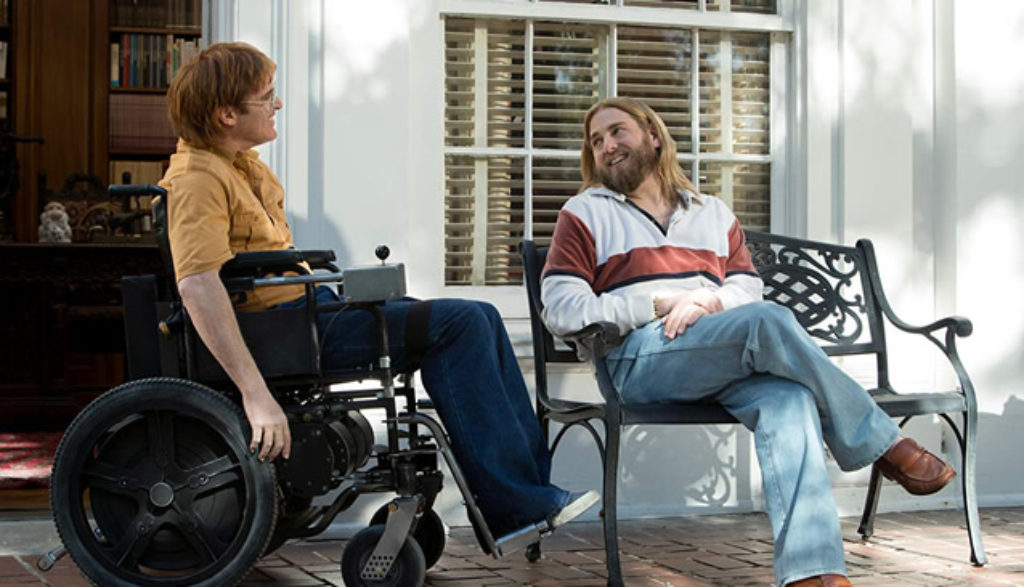
Suffering is universal. It’s this gnawing, brutal animal that takes on many a form with one purpose in mind: to destroy. It never asks permission.
But everyone who suffers has a choice. Suffering doesn’t have to dictate your existence.
John Callahan, an Oregon native, was born in the early 1950s and given up for adoption as a baby. When his existential pain of feeling abandoned could not be erased, he began to self-medicate with heavy amounts of alcohol at a young age.
Then one fateful night, he climbs behind the wheel while very drunk. He soon crashes, surviving by the skin of his teeth. A miracle, some say. But when he wakes up in the hospital and is told he will be forever confined to a wheelchair, John imagines that his life is over.
And he’s now left with only two choices: continue to self-medicate or find help.
Help is found in, perhaps, an unlikely place—Alcoholics Anonymous. As John realizes that he needs to gain control of his addiction, he learns about the power of honesty, the need for forgiveness as well as the beauty found in a loving embrace and an artistic touch.
As John Callahan makes his way through Alcoholics Anonymous’ 12 steps toward sobriety, he must confront his greatest fears, his buried emotions and some difficult buried memories. At those meetings, he befriends—and is befriended by—a group of similarly broken recovering addicts who gradually help him overcome his personal demons.
John’s friends are kind—with rough edges. They’re compassionate—but fierce. They don’t allow one another to make excuses for their poor choices. They dig into the roots of their problems (“provoking a sense of awareness,” they call it). And they always strive for the greatness they believe lives inside every individual, no matter how damaged. The program also teaches them how to let go of things that are outside of their control while fostering a sense of community.
During his fight for sobriety, John and his friends learn forgiveness of self and others. John goes to great lengths to meet people face to face; he apologizes for hurting them. His greatest feat, however, is in learning to forgive himself. As his budding career as a cartoonist takes off, he slowly learns how to love himself.
The film also sheds light on the realities that the disabled face on a daily basis—struggles with mobility, bathing and other basic daily functions.
Some teen boys, and other random passersby, help John perform menial tasks. John also saves another paralyzed friend whose wheelchair gets stuck on train tracks.
Several aspects of AA’s 12-step program, we see here, involve believing in and relying upon a “higher power” in the journey toward sobriety and healing. Step 2, for instance, requires believing in a higher power that can help restore sanity. Step 3 invites participants to turn their lives over to the care of God, in whatever way a person understands who God is. Additionally, other steps include confessing one’s personal defects and transgressions to that higher power.
Everyone in AA, including John, is encouraged to choose their higher power, who- or whatever it may be (Buddha, Jesus, etc.). They’re told that the only way to heal is to recognize the need for a transformative power outside of ourselves. Donnie, John’s AA sponsor, refers to God as the cursed doll Chuckie.
John and Annu (his girlfriend) talk about his prayers and all the requests he’s made since being paralyzed. She also asks him what he would ask of the devil if given the chance, and John tells her that he would give anything to be healed.
John also wrestles with hallucinations that his AA sponsor believes are a manifestation of difficult emotions as he walks toward sobriety. (One scene includes hand prints on John’s shoulder as he imagines his birth mother pushing and encouraging him to find happiness.) John makes a basket and labels it “God” so that he can throw his problems and questions into it.
A cross and a church serve as a prominent background in one scene. John wrestles with his Catholic background. A cartoon drawing shows Jesus hanging on the cross, mentions “the agony of Christ” and depicts evolution. Someone makes a rude comment about quickly finding salvation at church. Two men discuss the path to enlightenment and how difficult it is to teach others about faith.
Several scenes involve sexual activity as John tries to restart that aspect of his life, too. An oral sex scene involves movements and sounds, as does an explicit scene between John and Annu (which also includes sex-related dialogue).
Cartoon drawings depict various sexual acts. Other cartoons make jokes about lesbians. We hear conversations about various genders pairing in sex. A strip club scene pictures topless women. A video shows a naked man and woman having sex after paralysis. Derogatory sexual comments are made regarding the female and male anatomy.
John has various personal caretakers and friends who help him bathe. He’s shown unclothed from the back and lying in the bathtub as a friend washes his body. A woman who struggles with depression shares a story of a time she walked through her neighborhood completely naked.
Women are seen in bikinis and other revealing clothing. Men go shirtless. A man declares that he is a gay activist and reads a crude poem about male genitalia. We also see one man rubbing another’s shoulders affectionately in a park.
John meets a guy named Dexter at a party, and they drink uncontrollably. Though both are struggling even to walk, they get into a car and drive off. We hear that they crashed “into a pole at 90 m.p.h.” Dexter walks away with a few scratches, while John is seen lying on the ground, next to the car, nearly dead. The car is totaled and John is rushed immediately to the hospital.
As John struggles with sobriety, he often lashes out at people verbally and rams things intentionally with his wheelchair in anger. He pushes his wheelchair to the limit, often joining in on skateboarding stunts or moving so quickly that he’s catapulted out of his seat. Many of John’s drawings include violent images.
John shares a story of his siblings being beaten as children. A woman talks about a weapon used to hurt women’s breasts.
God’s and Jesus’ name are misused frequently, the former occasionally paired with “d–n.” We hear more than 50 uses of the f-word. Other profanities include the s-word, “a–,” “a–hole,” “d–n,” “d–k” and “son of a b–ch” Women are referred to as being “whores,” and other derogatory comments are made as well.
The whole story centers on John’s addiction to alcohol and his journey through the 12 steps of Alcoholics Anonymous.
While attending AA meetings, he hears about other addicts’ struggles with alcohol, Valium, sex and depression.
John’s own addiction to alcohol is extreme. He drinks around the clock (even pouring hard liquor into beer), and he suffers physical withdrawal symptoms (uncontrollable shaking) if he goes even an hour without ingesting alcohol. We see him toting around bottles of vodka, whiskey, gin, wine and anything else he can get his hands on. It matters less what he drinks, only that he is drinking.
Various scenes show people partying, smoking and knocking down shot after shot.
John has abandonment issues and struggles with anger. His cartoons often depict a dark and sadistic sense of humor, as well as mocking various groups of people (including members of the KKK, African-Americans, lesbians, feminists, lawyers, disabled people, liberals and conservatives). Some of his drawings also involve animals and feces
One woman mentions that her divorce has made her happier. A man audibly wonders, “Maybe life isn’t meant to be as meaningful as we think it is.” Someone vomits. Two people illegally sneak into an amusement park. A man makes a crass comment about wearing pants with feces in them and mentions stealing.
“I only know three things about my mom,” John tells us. “She was Irish-American, she was a schoolteacher, and she had red hair … oh yeah, and she didn’t want me, so that’s four things”
Don’t Worry, He Won’t Get Far on Foot is filled with pain and anguish, contrasted with bright moments of hope. As John faces multiple hardships, he learns to make the most of each moment. Instead of surrendering to despair, we see him slowly learn how to appreciate and value his own life as he dives into his work as an artist. As his sponsor, Donnie, tells him, “Maybe you were weakened to be stronger.”
The film (based on the real-life John Callahan’s book of the same name) offers a tangible sense of both loss and hope, and it struck me as a beautiful story about the power of confession, community, love and art.
But some of those beautiful moments sit close to raw, explicit ones, too. Director Gus Van Sant pulls no punches here. He aims his camera at John’s brokenness, and we hear and see it all: his profanity. His sexual activity. His alcohol use.
It’s messy, graphic stuff, imagery that makes this often-inspiring biographical movie a very difficult one to watch as well.

Kristin Smith joined the Plugged In team in 2017. Formerly a Spanish and English teacher, Kristin loves reading literature and eating authentic Mexican tacos. She and her husband, Eddy, love raising their children Judah and Selah. Kristin also has a deep affection for coffee, music, her dog (Cali) and cat (Aslan).